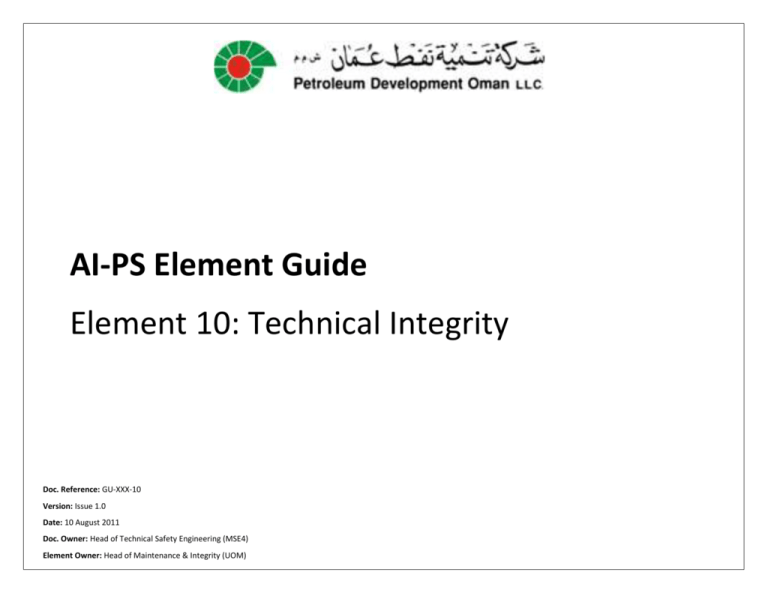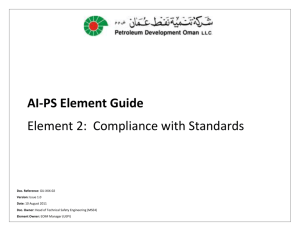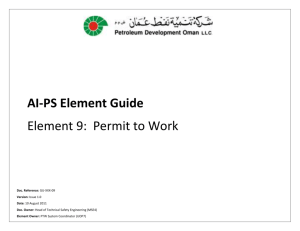Technical Integrity
advertisement

AI-PS Element Guide Element 10: Technical Integrity Doc. Reference: GU-XXX-10 Version: Issue 1.0 Date: 10 August 2011 Doc. Owner: Head of Technical Safety Engineering (MSE4) Element Owner: Head of Maintenance & Integrity (UOM) AI-PS Element Background There are 20 elements in total within the PDO AI-PS Management System as follows: AI-PS in PDO Elements list: Assuring the safety of our people, our assets, the environment and the company’s reputation is a core value of PDO and providing assurance that we are managing our major process safety risks is a critical aspect of our corporate governance. Asset Integrity Process Safety (AI-PS) describes the way we manage our assets so that the process risk is As Low As Reasonably Practicable (ALARP). What it is Asset Integrity Process Safety (AI-PS) is the means of ensuring that the people, systems, processes and resources, which deliver integrity, are in place, in use and fit for purpose throughout the whole lifecycle of the asset. The aim is to be able to confidently state that ‘our assets are safe and we know it’. Asset Integrity Process Safety Management is a complex area of expertise covering a wide range of components, all of which are essential to ensuring systems, processes and equipment perform as required. There are a number of Elements which make up the Asset Integrity Process Safety management system. Structure of AI-PS Assurance in PDO PDO has a three-tiered approach to AI-PS assurance: Level 1: Includes audits conducted on behalf of PDO's Internal Audit Committee (IAC) as part of the Integrated Audit Plan. This includes independent audits carried out by external bodies, such as Shell. Level 2: Includes audits carried out on behalf of Asset Managers as part of their own Asset level assurance processes. Level 3: Includes task verification and assurance activities that supplement the formal audit process. Element 1: Process Safety Culture Element 2: Compliance with Standards Element 3: Corporate Process Safety Competency Element 4: Workplace Involvement Element 5: Stakeholder Outreach Element 6: Process Knowledge Management Element 7: HEMP Element 8: Plant Operating Manuals Element 9: PTW Element 10: Technical Integrity Element 11: Contractor Management Element 12: Training and Performance Assurance Element 13: Management of Change Element 14: Readiness for Start Up Element 15: Conduct of Operations Element 16: Emergency Management Element 17: Incident Management Element 18: Measurements and Metrics Element 19: Audit and Verification of Level 2 Process Element 20: Management Review and Continuous Improvement Element 10: Technical Integrity Background to Element Effective Technical Integrity management is fundamental to extracting maximum business value from an Asset. It is a prerequisite to achieving sustainable business success and an essential part of the ‘License to Operate’ upholding Company reputation. It is, therefore, imperative to be able to verify and demonstrate to regulators, shareholders and other stakeholders that the Technical Integrity of the Assets are being managed effectively and that a system allowing continuous improvement is embedded in the organisation with the appropriate work processes and practices. Aims and Objectives of Element Technical Integrity ensures that equipment is properly designed, fabricated, installed and maintained in accordance with recognised standards and codes, and that it fulfils its design intent and remains fit for purpose until removed from operation. Technical Integrity is ensured by the existence and performance of a series of integrity barriers (Safety Critical Elements – SCE), which prevent or minimise the consequences of a Major Accident Hazard (MAH). There are eight SCE Hardware Barriers as detailed below: Structural Integrity; Process Containment; Ignition Control; Detection Systems; Protection Systems; Shutdown Systems; Emergency Response; Life Saving. The role of SCEs is to prevent or limit the escalation and/or consequences of a Major Accident Hazard. For each SCE identified at the asset, Performance Standards are developed which in turn inform the maintenance, testing and inspection requirements to ensure the integrity of the system. Scope of Element The scope of this element applies to all PDO assets and extends throughout the lifecycle of the facility. AI-PS Element Guide Implementation Aims and Objectives of AI-PS Element Guide The aim of this AI-PS Element Guide is to provide background to AIPS and a structured and consistent approach to carrying out Level 2 Self Assessments and Level 3 Verification for all AI-PS Elements within PDO. The intended audience for the guide are the members of the AI-PS Assurance Leadership Team (AIPSALT)although this can be used as a basis for training and awareness for all staff at the asset. Responsibilities and Accountabilities for AI-PS Element Guide Implementation The Operations Manager is accountable for the Level 2 Assurance process at the asset. Completion of the Level 2 Self Assessment and Level 3 Verification Checklists, as provided in this element guide, is the responsibility of the Element Champions and AIPSALT. The Delivery Team Leader (DTL) is accountable for the AIPSALT. AI-PS Assurance Leadership Team (AIPSALT) The AIPSALT is comprised of the asset DTL and Process Safety Element Champions (PSEC). The DTL and PSEC roles include: reporting the status of the Level 3 Verification activities for the relevant Element at the AIPSALT meeting; maintaining Key Performance Indicators (KPIs) for the Element; monitoring the effectiveness of the Level 3 Verification activities in assuring AI-PS, and recommending changes to improve effectiveness and efficiency as appropriate; monitoring the progress of corrective actions and improvement plans associated with that Element; and leading Level 2 Self-Assessment of compliance with the requirements of that Element. Level 2 Assurance Level 2 Self Assessment and Audit Level 2 assurance is provided by a series of AI-PS audits carried out on behalf of Asset Directors and Operations Managers as part of their own Directorate-Level assurance processes. Level 2 Audits (and Level 2 Self Assessments) are conducted at each Directorate using standard protocols and templates described in this series of AI-PS Element Guides. The Level 2 Self Assessment Checklist (provided in this AI-PS Element Guide) can be viewed as a ‘health check’ of asset performance again the element. Completing the Level 2 Self Assessment will help the asset to identify areas for improvement ahead of the Level 2 Audit. Frequency of Level 2 Assurance activities provide an ongoing check that the procedures, tests and inspections necessary to maintaining the functionality of Safety Critical Elements and systems are completed as required so that process risk is managed to a level that is As Low As Reasonably Practicable (ALARP). In summary, the Level 3 Checklists are an operational level sample check or ‘mini audit’ completed by the asset against PDO and asset based procedures. The effectiveness of the Level 3 Verification process is assessed during the Level 2 Self Assessment process and ultimately via the Level 2 Audit programme. Verification Checklists Level 3 Verification checklists have been developed for each AI-PS Element within PDO in order to provide a structured and consistent approach to Level 3 Verification across all assets. The Level 3 Verification checklists are structured as a sample check or specific and localised audit of the Element in question. Level 2 Audits are conducted annually at each Directorate but the frequency and duration may be adjusted to reflect either positive or negative trends, recent audit findings, emerging risks and alignment with other audit activities. The schedule of Level 2 audits is set in the Directorate HSE Plan. By successfully verifying that the Level 3 Verification activities are being completed correctly it provides a strong indication that the element is being implemented at the ’system level’ (assessed via the Level 2 Self Assessment and Level 2 Audits). The frequency of Level 2 Self Assessment should also reflect how well the asset is performing against all AI-PS Elements and be performed no less than on an annual basis (ahead of the Level 2 Audit). The Level 2 Self Assessment for this element is provided below. The Level 3 Verification Checklist is maintained by UOM – please contact the Element Owner (UOM) for details. Level 3 Verification Checklist Level 3 Verification Description Level 3 Verification demonstrates compliance with the asset HSE Case ‘barriers’, HSE Critical Tasks, operational procedures and other requirements defined in the HSE Management System. These Level 2 Self Assessment SN Protocol Y / N / NA & Evidence Possible Approach Hardware Barrier Assessment (HBA), EP2010-9002 10.1 Does the asset have a risk-based five-year plan for Level 3 Technical Integrity Verification (HBAs)? Note that the minimum annual sampling is: one (1) SCE group sampled from each barrier and a minimum of four (4) SCE groups sampled from the Process Containment barrier and two (2) from the Ignition Control barrier. 10.2 Have completed Level 3 Technical Integrity Verification (HBAs) been based on a site visit, including a detailed facility walk-through, close inspection of equipment and structured interviews with field-based staff? Review Level 3 verification documentation. 10.3 Has Level 3 Technical Integrity Verification (HBAs) taken place in the last twelve months? Review Level 3 verification documentation. 10.4 Have the engineering TA-1s been involved in defining the risk-based five year plan for Level 3 Technical Integrity Verification (HBAs)? Review five year plan and discuss risk based priorities with relevant TA-1. 10.5 Is the number and types of equipment sampled in the Level 3 Technical Integrity Verification (HBAs) for a selected SCE group sufficient to form an opinion of Technical Integrity? 10.6 Have all “Technical Integrity Not Demonstrated” findings and associated corrective actions been logged in the AI-PS Action Tracking Tool? Have equipment corrective actions been entered in SAP with due dates set using the Corrective Maintenance Prioritisation Tool (CMPT)? 10.7 Have copies of the Level 3 Technical Integrity Verification (HBAs) been sent to CFDH of Maintenance & Integrity? 10.8 Have Level 3 Technical Integrity Verification (HBAs) actions open for longer than 12 months been re-assessed for priority against the Corrective Maintenance Prioritisation Tool (CMPT)? Review outstanding actions in the tracking tool for accuracy, status and quality of close out. Review SAP and FSR for associated deviations and form an opinion on the adequacy of mitigation measures in place for the identified shortfall. Review actions that have been open for 12 months or more and confirm CMPT prioritisation? SN Protocol Y / N / NA & Evidence Possible Approach SCE Management (Asset Setup), EP20099009 10.9 Have all hardware barriers identified in the Operations HSE Case been identified as SCE in the Asset Register? Sample equipment in the Asset Register and confirm that they have been assigned SCE status in accordance with the HSE Case. 10.10 Has the SCE identification process been documented for the asset? 10.11 Have operations Performance Standards (including acceptance criteria) been identified in the Asset Register for all identified SCEs? 10.12 Have the operations Performance Standards been approved by the relevant Technical Authority? Check for description in the HSE Case or SCE identification report (on recent projects/modifications). Cross reference selected SCE from Asset Register and confirm Performance Standards have been developed. Ensure that the Performance Standards are valid for the asset. Review Performance Standards approval signatures and confirm approval by relevant TA. 10.13 Is there a management of change process in place for SCEs and their performance standards (additions, removal and modifications)? 10.14 Have the asset SCE listing and Performance Standards been reviewed in the last five years? Check for TA approval of changes. SCE Management (Asset Execution), EP2009-9009 10.15 Have performance assurance task results been accurately recorded in SAP? 10.16 Have deviations been raised against all nonconformances? 10.17 Have follow on corrective maintenance notifications been prioritised using the CMPT? 10.18 Have all temporary repairs been approved by the relevant Technical Authority? Sample check SAP for selected SCEs. Does the record give clear information on whether Performance Standard criteria was achieved, e.g. with reference to instrument reading or measurement value where appropriate? How are non-conformances managed and prioritised? Is there a risk based resolution? Are deviations left in ‘Draft’ status for extended periods? Inspect corrective maintenance plans to confirm application of CMPT Identify existing temporary repairs at the asset and review supporting technical assessment / risk assessment – confirm relevant TA sign off. SN Protocol Y / N / NA & Evidence Possible Approach 10.19 Are approved deviations supported by a formal risk assessment, consultation of Technical Authorities, and are the mitigating actions in place and will remain in place for the duration of the deviation? Review FSR for active deviations. 10.20 Are all open deviations within their agreed expiry date? Sample check open deviations and confirm expiry dates. 10.21 Does the Facility Status Report reflect the current Technical Integrity status for all SCE groups? 10.21.1 Structural Integrity 10.21.2 Process Containment (wells) 10.21.3 Process Containment (non-wells) 10.21.4 Ignition Control 10.21.5 Detection Systems 10.21.6 Protection Systems 10.21.7 Shutdown Systems 10.21.8 Emergency Response 10.21.9 Life Saving 10.22 Does the SCE Preventative Maintenance (PM) and Corrective Maintenance (CM) compliance values and trends indicate that the work is adequately under control? 10.23 Does asset management regularly review maintenance compliance and FSR status? Look for minutes of meetings. Temporary and Third Party Equipment 10.24 Is there an integrity assurance plan for temporary equipment in PDO process facilities and hydrocarbon areas? 10.25 Is the use of temporary equipment in accordance with PR-1960 including registration, inspection and maintenance requirements? Have maintenance requirements for temporary equipment been identified? Are requirements reviewed by relevant TA-2s? SN 10.26 Protocol Is temporary equipment assessed for impact on Major Accident Hazards and interfaces with existing SCEs at the asset? Y / N / NA & Evidence Possible Approach AI-PS Level 3 Technical Integrity Verification Checklist The Technical Integrity Level 3 Verification Checklist is maintained by the UOM group – please contact the Element Owner (UOM) for details.









